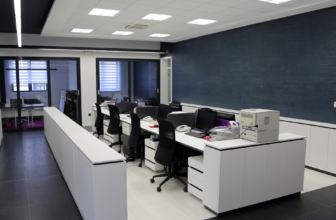
When selecting office storage solutions, you must carefully evaluate various factors to optimize your workspace effectively. From the layout of your office to the accessibility of items, each aspect plays a crucial role in enhancing productivity. Considering your storage needs and planning for future growth are key components in making informed decisions. Moreover, keeping budget constraints and long-term objectives in mind ensures a strategic investment in storage solutions that align with your organizational goals. So, what specific criteria should guide your choice to create an efficient and organized office environment?
Office Space Layout
When organizing your office space layout, consider the flow of work and accessibility to essential items. The layout should promote efficiency and productivity by positioning frequently used items within easy reach. Arrange your desk, chair, and computer in a way that allows for seamless movement between tasks. Keep important documents and supplies close by, ensuring you can quickly locate and retrieve them as needed.
Additionally, consider the placement of office equipment such as printers, scanners, and shredders. These items should be strategically located to minimize disruptions while maximizing their utility. Create designated areas for different functions, such as a printing station away from your main workspace to reduce noise and distractions.
Furthermore, think about the overall aesthetics of your office space layout. A clean and organized environment can have a positive impact on your mindset and work performance. Use storage solutions that not only enhance functionality but also contribute to a visually appealing workspace. By carefully planning your office space layout, you can create a conducive environment that supports your daily tasks and enhances your overall work experience.
Storage Needs Assessment
Consider assessing your storage needs to optimize the organization of your office space effectively. Start by evaluating the types of items you need to store, such as documents, supplies, or equipment. Determine the quantity of each item to estimate the amount of storage required. Take into account any future growth or changes in your business that may impact your storage needs. Consider how frequently you need to access different items to plan for convenient placement within your office.
Additionally, assess the current storage solutions in your office to identify any inefficiencies or areas for improvement. Look for unused or underutilized spaces that could be repurposed for storage. Evaluate the accessibility and ease of use of your existing storage systems to pinpoint any pain points that need to be addressed.
Accessibility and Convenience
Assess the ease of access and convenience of your current storage systems to identify areas for improvement and enhance efficiency in your office space. Consider how easily you can retrieve items stored in different locations. Opt for storage solutions that allow for quick and convenient access to frequently used items. Utilize open shelving units or cabinets with clear labeling to help you locate items efficiently. Additionally, evaluate the layout of your storage areas to ensure that commonly accessed items are within reach, while seasonal or rarely used items are stored away.
When selecting office storage solutions, prioritize accessibility to enhance productivity. Choose storage options that cater to your workflow and daily tasks. For example, mobile storage units or rolling cabinets can provide flexibility and easy access to materials needed at various workstations. Implement ergonomic storage solutions that promote accessibility while maintaining a clutter-free workspace. By focusing on accessibility and convenience, you can streamline your workflow and create a more organized office environment.
Budget and Long-Term Planning
To effectively manage your office storage solutions, it's imperative to establish a budget and develop a long-term plan that aligns with your organizational goals and financial resources. When considering your budget, think about not only the initial costs of purchasing storage solutions but also ongoing maintenance expenses. Opt for quality storage options that may require a higher initial investment but result in long-term cost savings due to their durability. Additionally, factor in any potential expansion needs to ensure your storage solutions can grow with your business.
Long-term planning involves thinking ahead and anticipating future storage requirements. Consider the scalability of the storage solutions you choose and whether they can adapt to your evolving needs. Investing in flexible storage systems can save you money in the long run by avoiding the need for frequent replacements or upgrades. By aligning your budget with your long-term plan, you can make informed decisions that support your organization's growth and efficiency.




